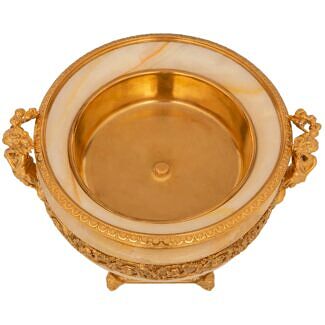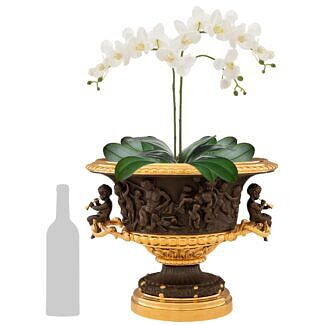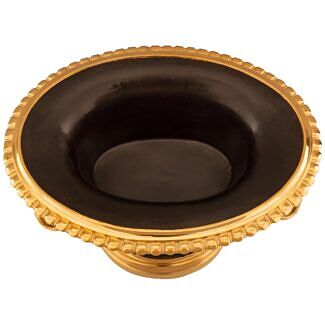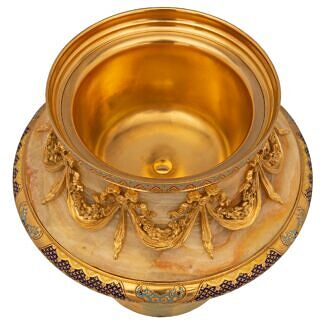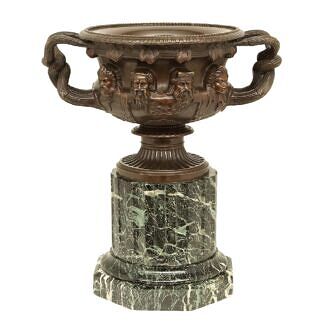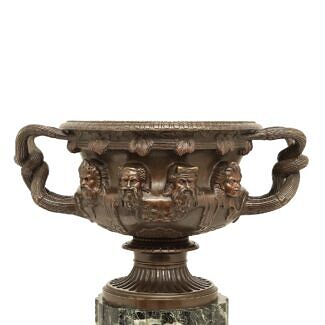A French 19th century Belle Epoque Period Neo-Classical st. Ormolu and patinated Bronze jardiniere urn, in the manner of Clodion
A stunning and high quality French 19th century Belle Epoque Period Neo-Classical st. Ormolu and patinated Bronze jardiniere urn, in the manner of Clodion. This most elegant planter/urn is raised on four scrolled legs with pawed feet and acanthus leaves... — Read More
A stunning and high quality French 19th century Belle Epoque Period Neo-Classical st. Ormolu and patinated Bronze jardiniere urn, in the manner of Clodion. This most elegant planter/urn is raised on four scrolled legs with pawed feet and acanthus leaves leading up each leg. A wonderful reeded base plate accents the bottom of the urn and is finished with an inverted foliate finial. Above is a thick and richly chased protruding band of circular rosettes which connects the two handles displaying ram's heads at their base and scrolled foliate movements above. At the midsection of the planter is an exceptional and high quality wrap around reserve of charming cherubs playing. The urn is finished with a smooth patinated Bronze interior. — Read Less
- Item # 14517
-
H: 14.75 in L: 13 in D: 12.75 in
H: 37 cm L: 33 cm D: 32 cm
- France
- 19th Century
- Ormolu, Patinated Bronze
-
Belle Époque Period Read More,
Neo-Classical st. Read More
(Belle Époque Period) -
Gaining its name from the optimistic and peaceful period of time between 1871 and World War I, Belle Epoque means “beautiful period”, and occurred during the era of the Third French Republic. This period of economic, colonial, and scientific prosperity brought with it a flourishing artistic climate with numerous literal, musical, theatrical, and visual masterpieces being created.
The Eiffel Tower, which was constructed between 1887 and 1889, served as the entrance to the World’s Fair held in Paris. That same year, the Moulin Rouge cabaret in Paris was founded and showcased the now more mainstream styles of performance including can-can dancing. Belle Epoque dancers and singers were Paris celebrities and became immortalized by the poster arts of Toulouse-Lautrec.
Leading up to this period in 1865, the American Civil War was coming to a close, with France proposing to construct the Statue of Liberty as a joint effort with the United States. France would be responsible for the statue, with America constructing the pedestal. Created to celebrate the nation’s success in building a viable democracy, the statue would stand as a symbol of friendship between the French and American people.
(Neo-Classical st.) -
One of the top design styles in modern interiors is Neo-Classical. Developed in the 18th century, artists of this time sought to move away from the abundance of decoration saw in the Rococo style and shift towards a more restrained and moderate style.
As a result of this, excessive ornamentation was left behind with the new focus being on symmetry and minimalism. Architectural elements like columns and cornices were now the star of the show and were paired with linear furniture to showcase the beauty of the architecture.
The Neo-Classical decorating style is modest and chic, with decorative pieces being strategically placed with moldings and cornices being the finishing touch. Tall walls, large expansive windows, and columns are key features of any Neo-Classical design.
- Claude Michel Read More
Claude Michel, aka Clodion (1738 – 1814) Was a renowned French Master sculptor Born in Nancy, France. In 1755, Clodion went to Paris and was a pupil of J. B. Pigalle. In 1759 he obtained the grand prize for sculpture at the Académie Royale; in 1761 the silver medal for studies from models; and in 1762 he went to Rome. Catherine II of Russia was eager for him to go and stay in St Petersburg, but he returned to Paris. Among his patrons, were the chapter of Rouen, the states of Languedoc, and the Direction Générale. His works were frequently exhibited at the Salon. Among Clodion's works, that are displayed all over the world, are a statue of Montesquieu and a Dying Cleopatra, in the Victoria and Albert Museum, (London). One of his last groupings represented Homer as a beggar being driven away by fishermen (1810).
Claude Michel works may be seen at: the Art Institute of Chicago, the Bowes Museum (County Durham, UK), the Carnegie Museum of Art (Pittsburgh), the Courtauld Institute of Art (London), the Fine Arts Museums of San Francisco, the Frick Collection (New York City), the Getty Museum (Los Angeles), the Kimbell Art Museum (Texas), the Louvre (Paris), the Metropolitan Museum of Art, Musée Cognacq-Jay (Paris), the Museum of Fine Arts (Boston), Musée des Beaux-Arts (Bordeaux), Museum Boijmans Van Beuningen (Rotterdam), the National Gallery of Armenia, the National Gallery of Art (Washington.), the Norton Simon Museum (Pasadena) and the Philadelphia Museum of Art.
Payment Plan Option Learn More Choose the payment plan option at checkout and customize this payment option with our team. Payment plans are flexible and items will ship once all payments are received.





















